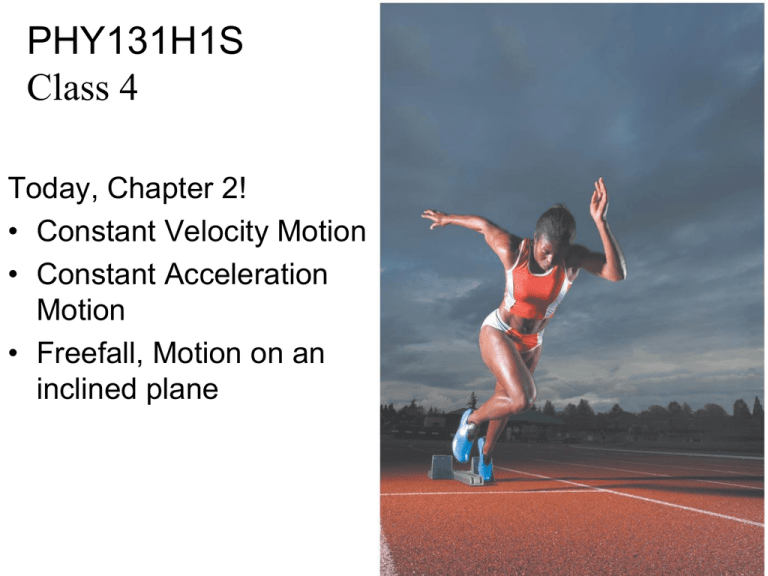PHY131H1S Class 4
advertisement

PHY131H1S Class 4 Today, Chapter 2! • Constant Velocity Motion • Constant Acceleration Motion • Freefall, Motion on an inclined plane Pre-class reading quiz Practicals • Note that practicals begin this week. • You will be sitting with 3 other people from this course, and the 4 of you will form a team. • You will be working on practicals activities together • Teams are scrambled after Reading Week. • My message: “You are not alone!” Don’t try to get through this course all by yourself! Last day I asked at the end of class: • Does constant velocity imply constant acceleration? • ANSWER: • Does constant acceleration imply constant velocity? • ANSWER: Instantaneous Acceleration The instantaneous acceleration as at a specific instant of time t is given by the derivative of the velocity Note: Knight uses “s” to denote a distance in a general direction. Usually in problems we substitute x or y instead of s. Finding Velocity from the Acceleration If we know the initial velocity, vis, and the instantaneous acceleration, as, as a function of time, t, then the final velocity is given by Or, graphically, Which velocity-versus-time graph goes best with the position-versus-time graph on the left? Which position-versus-time graph goes with the velocity-versus-time graph at the top Which velocity-versus-time graph or graphs goes with this acceleration-versus-time graph? Motion with Constant Acceleration Strategy: When a = constant, you can use one of these equations. Figure out which variable you don’t know and don’t care about, and use the equation which doesn’t contain it. The Physics of Superheroes ©2009 by James Kakalios available at Chapters.ca for $15 • In the original comic, Superman only had superstrength and very tough skin! •He could “leap tall buildings in a single bound.” •It was not until the 1940s that the writers changed his abilities to included guided flying. Example Question. Superman’s parents came from a planet where the gravity was much stronger. His race has legs strong enough to jump to a maximum height of 1.0 m on planet Krypton. On Earth, Superman can jump to a maximum height of 25 m. (a tall building in 1938!) What was the acceleration due to gravity on planet Krypton? Example Question & Demo – using Error Analysis. A small object is dropped from a height of yi = 3.00 ± 0.01 m. yf = 0 m. The time of flight is Δt ± σt. Estimate g in this room. MODEL: Neglect air resistance: a = −g. This is called “free-fall” Propagation of Errors Sum rule: Product rule: Multiplying by exact constant: Power rule: z = A x Δz = A Δx Before Class 5 on Monday • Please read Chapter 3 of Knight. • Something to think about: Can you add a scalar to a vector? Can you multiply a vector by a scalar?

